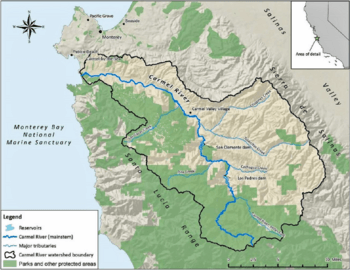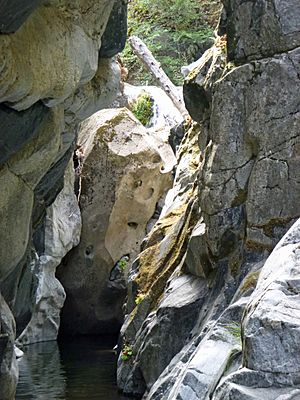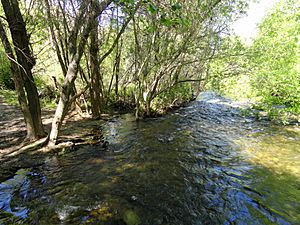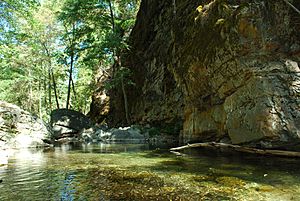Carmel River (California) facts for kids
Quick facts for kids Carmel River |
|
|---|---|
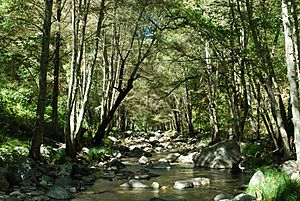
Carmel River in the Ventana Wilderness
|
|
|
Location of the mouth of the Carmel River in California
|
|
| Native name | tirus ua čorx |
| Other name(s) | Rio del Carmelo Nuestra Senora del Monte Carmelo |
| Country | United States |
| Physical characteristics | |
| Main source | Santa Lucia Mountains 4,120 ft (1,260 m) 36°19′05″N 121°38′44″W / 36.318018°N 121.645501°W |
| River mouth | Pacific Ocean Sea level 36°32′10″N 121°55′41″W / 36.536072°N 121.928010°W |
| Length | 36 mi (58 km) |
| Basin features | |
| Basin size | 256 sq mi (660 km2) |
| Tributaries |
|
The Carmel River is a beautiful river on the Central Coast of California. It flows for about 41 mi (66 km) through Monterey County. The river starts high up in the Santa Lucia Mountains. It then winds its way northwest through the Carmel Valley. Finally, it reaches the Pacific Ocean near Carmel-by-the-Sea. The Carmel River is also seen as the northern edge of the famous Big Sur coastline.
Contents
History of the Carmel River
Before Europeans arrived, two main groups of Native Americans lived along the Carmel River. The Rumsen Ohlone people lived closer to the ocean. The Esselen people lived further upstream. Both groups later became part of the Carmel Mission.
A Spanish explorer named Sebastián Vizcaíno was the first European to see the river's mouth. This happened in December 1602. He wrote about visiting the river in January 1603. He named it Rio del Carmelo because three Carmelite friars were with him.
Later, in 1771, Fathers Junípero Serra and Juan Crespí moved the Carmel Mission. They moved it from Monterey to its current spot by the Carmel River. They had Native American workers dig ditches. These ditches brought water from the river to help their crops grow. The Carmel River has been a water source for local people ever since.
In 1883, a railroad builder named Charles Crocker built a dam on the river. It was called the Chinese Dam. This dam helped supply water to his new Hotel Del Monte.
Famous author John Steinbeck wrote about the river in his 1945 novel, Cannery Row. He said, "The Carmel is a lovely little river. It isn't very long but in its course it has everything a river should have."
What is the Carmel River Watershed?
A watershed is an area of land where all the water drains into one main river or body of water. The Carmel River watershed covers about 256 square miles (660 km2). It starts high up on Miller Mountain. This area is part of the Ventana Wilderness in the Los Padres National Forest.
Most of the water in the Carmel River comes from the Santa Lucia Mountains. About 96% of the river's flow comes from smaller streams, called tributaries, in these mountains. Some important tributaries are San Clemente Creek and Cachagua Creek. The river's total length from its start to the ocean is about 41 miles (66 km).
Amazing River Life (Ecology)
The Carmel River flows through many different habitats, which are natural homes for plants and animals. Near the riverbanks, you'll find a special area called the riparian zone. Higher up, the river passes through mixed evergreen forests. Here, you can see tall coast redwoods and Coast Douglas firs. You might even spot the rare Santa Lucia fir, which only grows in this area.
As the river flows lower, it goes through mountain chaparral and woodlands. Closer to the ocean, it passes through coastal sage and chaparral and coastal prairie. Finally, it reaches the ocean through small sand dunes.
Many projects are working to help the river's ecosystem. An ecosystem is a community of living things and their environment. These projects help fish like the steelhead trout return to the river. Steelhead trout are a type of salmon that are listed as "threatened" under the Endangered Species Act. This means they need protection to survive.
One big project was removing the San Clemente Dam. This helped steelhead trout swim upstream to lay their eggs. The Carmel River has the largest population of steelhead trout in this part of California. Adult steelhead can now use many miles of the river and its tributaries for spawning. However, the Los Padres Dam still blocks some fish from moving freely. To help, adults are caught and moved above the dam. Young fish are guided through a chute to get around it.
Another threatened animal living in the river is the California red-legged frog. This frog is native to the area.
The Hastings Natural History Reserve is a special place near the river. It's a field station for the University of California, Berkeley. Scientists study animals and plants there.
Dams and Reservoirs
The Carmel River once had three dams. Dams create reservoirs, which hold water for drinking. These dams also had a problem with too much sediment (silt and sand) building up behind them.
The San Clemente Dam was built in 1921. It was about 18.5 miles (29.8 km) from the ocean. This dam used to provide drinking water for the Monterey Peninsula. Over time, it filled up with silt. By 2002, it was 90% full of sediment. Experts worried it might collapse in an earthquake.
In 2010, a plan was made to remove the dam. The project was finished in 2015. It involved digging a new channel for the river to flow around the dam. This was a huge success! It opened up about 6.5 miles (10.5 km) of new habitat for steelhead trout. It also gave them access to three important tributary creeks: San Clemente Creek, Pine Creek, and Cachagua Creek. This was one of the biggest dam removals in North America at the time.
The Los Padres Dam was built in 1949. It is about 26 miles (42 km) upstream from the ocean. This dam also collects sediment. When big fires happen, like the 1977 Marble Cone Fire, a lot more sediment can wash into the river. The Los Padres Dam helps keep water flowing in the river during the summer. However, it still blocks the natural movement of wood and gravel, which are important for the river. It also makes it harder for steelhead trout to migrate.
The oldest dam on the river was a small one built around 1880. It was called the "Chinese Dam" or "Old Carmel River Dam." It was built by Charles Crocker with the help of about 700 Chinese workers. This dam sent water through a long iron pipe to the first Del Monte Hotel. This old dam was also removed as part of the San Clemente Dam removal project.



